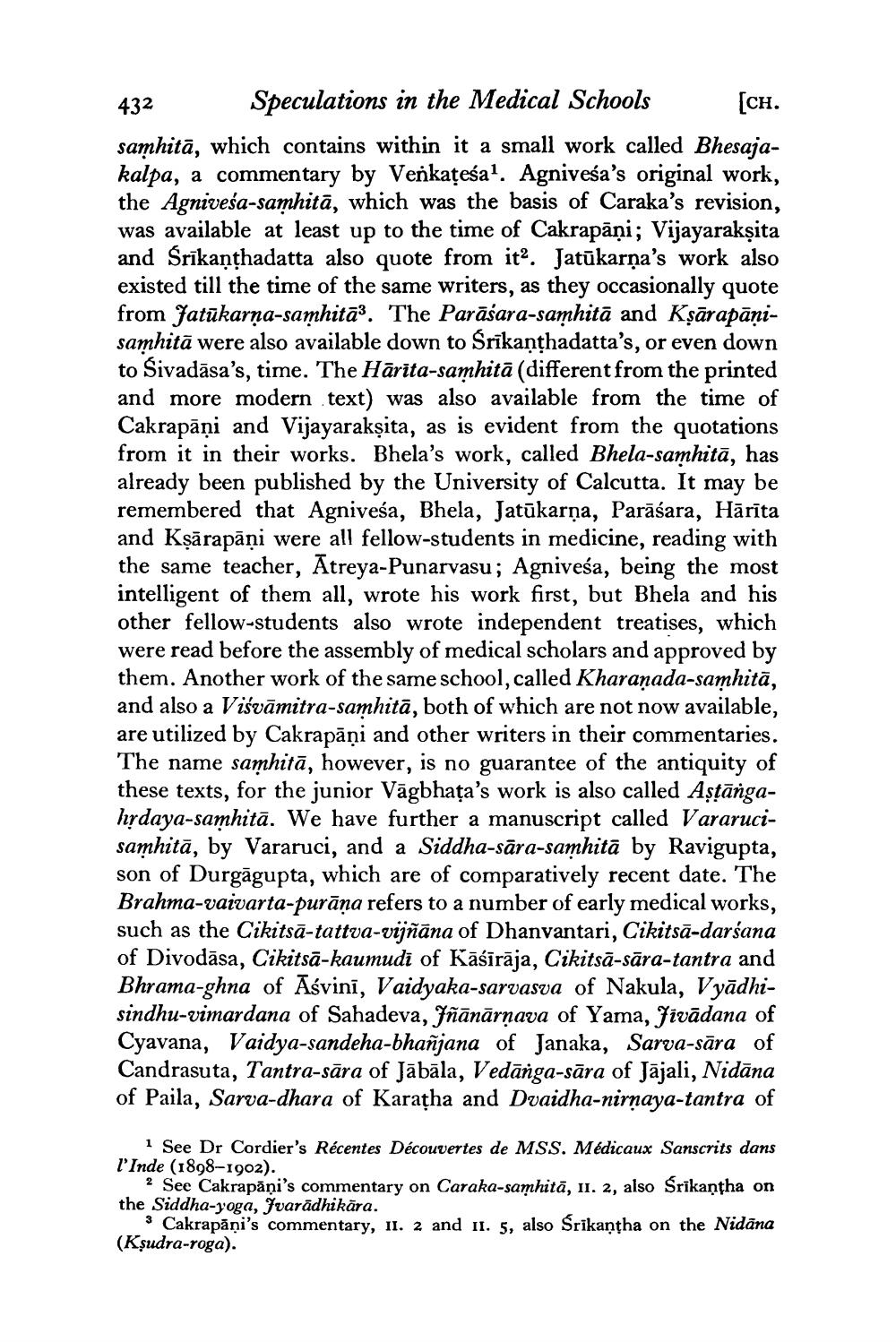________________
432
Speculations in the Medical Schools
[CH.
samhita, which contains within it a small work called Bhesajakalpa, a commentary by Venkatesa1. Agnivesa's original work, the Agnivesa-samhita, which was the basis of Caraka's revision, was available at least up to the time of Cakrapāņi; Vijayarakṣita and Srikanthadatta also quote from it2. Jatūkarņa's work also existed till the time of the same writers, as they occasionally quote from Jatukarṇa-samhita3. The Parāśara-samhitā and Kṣārapāņisamhita were also available down to Srikanthadatta's, or even down to Śivadāsa's, time. The Harita-samhita (different from the printed and more modern text) was also available from the time of Cakrapāņi and Vijayarakṣita, as is evident from the quotations from it in their works. Bhela's work, called Bhela-samhita, has already been published by the University of Calcutta. It may be remembered that Agniveśa, Bhela, Jatūkarṇa, Parāśara, Hārīta and Kṣārapāņi were all fellow-students in medicine, reading with the same teacher, Atreya-Punarvasu; Agniveśa, being the most intelligent of them all, wrote his work first, but Bhela and his other fellow-students also wrote independent treatises, which were read before the assembly of medical scholars and approved by them. Another work of the same school, called Kharaṇada-samhitā, and also a Visvamitra-samhitā, both of which are not now available, are utilized by Cakrapāņi and other writers in their commentaries. The name samhita, however, is no guarantee of the antiquity of these texts, for the junior Vägbhata's work is also called Aṣṭāngahrdaya-samhita. We have further a manuscript called Vararucisamhita, by Vararuci, and a Siddha-sāra-samhitā by Ravigupta, son of Durgagupta, which are of comparatively recent date. The Brahma-vaivarta-purāṇa refers to a number of early medical works, such as the Cikitsā-tattva-vijñāna of Dhanvantari, Cikitsā-darśana of Divodāsa, Cikitsā-kaumudi of Kāśīrāja, Cikitsā-sāra-tantra and Bhrama-ghna of Aśvinī, Vaidyaka-sarvasva of Nakula, Vyadhisindhu-vimardana of Sahadeva, Jñānārṇava of Yama, Jivādana of Cyavana, Vaidya-sandeha-bhañjana of Janaka, Sarva-sāra of Candrasuta, Tantra-sāra of Jābāla, Vedānga-sāra of Jājali, Nidāna of Paila, Sarva-dhara of Karatha and Dvaidha-nirnaya-tantra of
1 See Dr Cordier's Récentes Découvertes de MSS. Médicaux Sanscrits dans l'Inde (1898-1902).
2 See Cakrapani's commentary on Caraka-samhitā, II. 2, also Śrīkantha on the Siddha-yoga, Jvaradhikara.
3 Cakrapani's commentary, II. 2 and 11. 5, also Śrikaṇṭha on the Nidāna (Kṣudra-roga).




